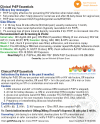Public Health Detailing on Sexual Health Care in San Francisco: Learnings From Real-World Implementation
- PMID: 35264028
- PMCID: PMC10031821
- DOI: 10.1177/00333549221081130
Public Health Detailing on Sexual Health Care in San Francisco: Learnings From Real-World Implementation
Abstract
Objectives: Public health detailing is an intervention in which a public health professional visits health care providers to educate them about evidence-based approaches to improve health. The San Francisco Department of Public Health conducted a public health detailing program from 2016 to 2018 to improve sexual health care and preexposure prophylaxis services in the city.
Methods: We conducted a mixed-methods study to understand the implementation of detailing and explore examples of changes to clinicians' clinical behaviors. We surveyed 203 clinicians, conducted 60-minute qualitative interviews with 7 clinicians and 4 detailers, and analyzed tracking forms. We used descriptive statistics to assess associations in the surveys. We used qualitative thematic analysis to understand facilitators and barriers to detailing and identify ways to improve the process and identify its potential benefits.
Results: In interviews, both clinicians and detailers had a favorable view of detailing as a tool to connect health department expertise to clinicians. Detailers cited challenges such as limited clinic time, provider turnover, and policies that limit their access to clinicians. These challenges may attenuate the real-world benefits of detailing. Clinicians offered examples of how detailing altered their behaviors, such as taking sexual health histories, building knowledge and confidence about sexual health, and using health department services. Matched surveys (n = 21) showed preliminary changes to prescribing preexposure prophylaxis.
Conclusions: Public health detailing is a promising approach to increase clinicians' knowledge and confidence to offer sexual health care services, build buy-in, and support connection to health departments. Detailing programs require sufficient investment and staff support to build lasting and collaborative relationships between clinicians and public health departments and to assess the impact of the intervention.
Keywords: HIV/AIDS; preventive medicine; public health detailing; qualitative methods; sexual health.
Conflict of interest statement
The authors declared no potential conflicts of interest with respect to the research, authorship, and/or publication of this article.
Figures


References
-
- Centers for Disease Control and Prevention. Sexually transmitted disease surveillance 2019: reported STDs in the U.S. reach all-time high for 6th consecutive year. 2019. Accessed April 23, 2021. https://www.cdc.gov/std/statistics/2019/default.htm
-
- San Francisco Department of Public Health. HIV semi-annual surveillance report: HIV cases diagnosed through December 2020 and reported through February 2021. 2016. Accessed April 24, 2021. https://www.sfdph.org/dph/files/reports/RptsHIVAIDS/semi_annual_report_2...
-
- San Francisco City Clinic. San Francisco monthly STD report. 2021. Accessed December 7, 2021. https://www.sfdph.org/dph/files/reports/StudiesData/STD/STD082021.pdf
-
- San Francisco Department of Public Health. HIV epidemiology annual report. 2018. Accessed November 20, 2020. https://www.sfdph.org/dph/files/reports/RptsHIVAIDS/HIV-Epidemiology-Ann...

